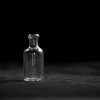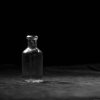Rob MacKillop
Edinburgh Correspondent
I want to learn more about still life shooting, lighting, etc, and there is a one-day course at STILLS, Edinburgh's most excellent photography centre: https://stills.org/products/courses-learning/?orderby=course_level They call it Product Photography: https://stills.org/product/project-day-product-photography/ but the essentials are the same.
It's this Sunday, 11am to 5pm. So, to get in the mood I set up my low-tech studio!

There was only a little light coming in from the large front window, it being a REALLY dull day, so I supplemented the light with a regular floor-stand lamp. I switched off the overhead light. There was also some light coming in from the hallway. Not exactly a pro studio!
I quickly arranged some stuff on a chair, but it wasn't high enough to shoot without me crouching down, and the old knees don't like that anymore, so I placed another chair underneath that one.
I took a few shots with the Monochrom. The tripod shots were boring, but the hand-held a little more interesting. I also shot both dng raw and jpg. After trying various exposures and f-stops, this one turned out best. I present first a jpg version of the raw file, then the in-camera simultaneous jpg. At this size there is not much difference, but I can certainly see a difference in clarity when zoomed in. Both are cropped to 7 by 6 format, which I really like from my days with a Mamiya RB67.
Anyway, not the best still lifes (lives?) ever, but the experience has whet my appetite for Sunday's class.
I'd much prefer good natural light, but that was in short supply.
I'll be trying focus stacking with Helicon Focus, but I'm not sure if that is for me.


It's this Sunday, 11am to 5pm. So, to get in the mood I set up my low-tech studio!

There was only a little light coming in from the large front window, it being a REALLY dull day, so I supplemented the light with a regular floor-stand lamp. I switched off the overhead light. There was also some light coming in from the hallway. Not exactly a pro studio!
I quickly arranged some stuff on a chair, but it wasn't high enough to shoot without me crouching down, and the old knees don't like that anymore, so I placed another chair underneath that one.
I took a few shots with the Monochrom. The tripod shots were boring, but the hand-held a little more interesting. I also shot both dng raw and jpg. After trying various exposures and f-stops, this one turned out best. I present first a jpg version of the raw file, then the in-camera simultaneous jpg. At this size there is not much difference, but I can certainly see a difference in clarity when zoomed in. Both are cropped to 7 by 6 format, which I really like from my days with a Mamiya RB67.
Anyway, not the best still lifes (lives?) ever, but the experience has whet my appetite for Sunday's class.
I'd much prefer good natural light, but that was in short supply.
I'll be trying focus stacking with Helicon Focus, but I'm not sure if that is for me.


Last edited:




